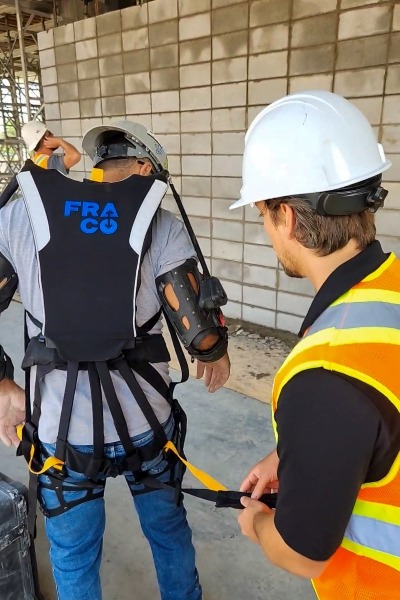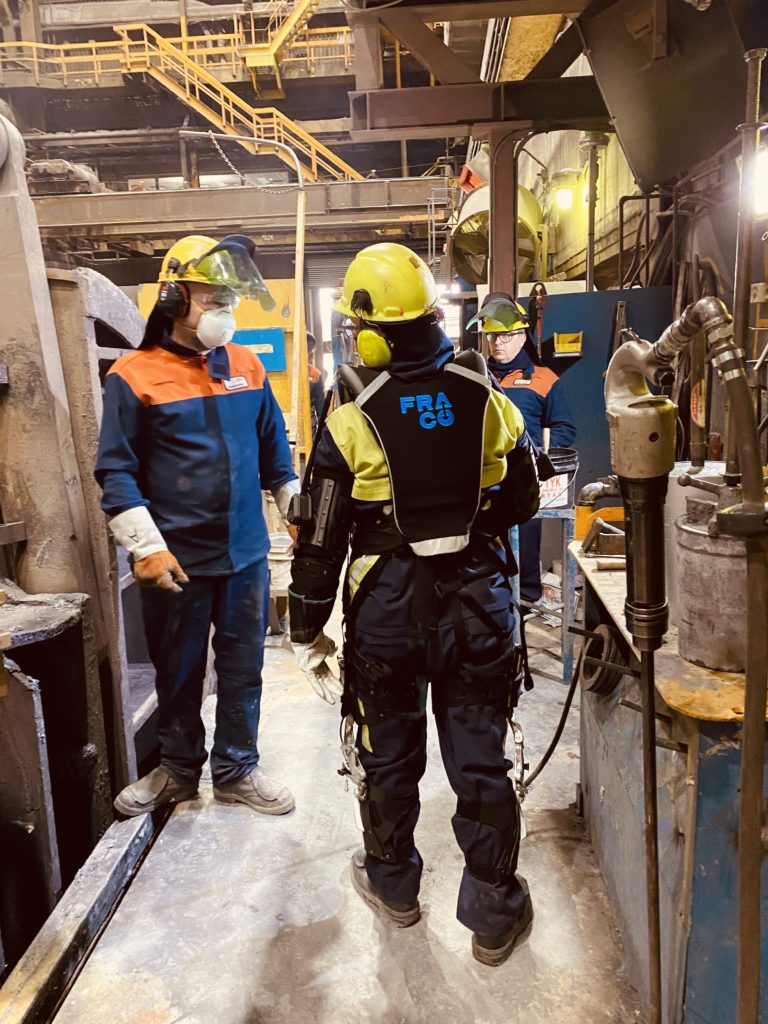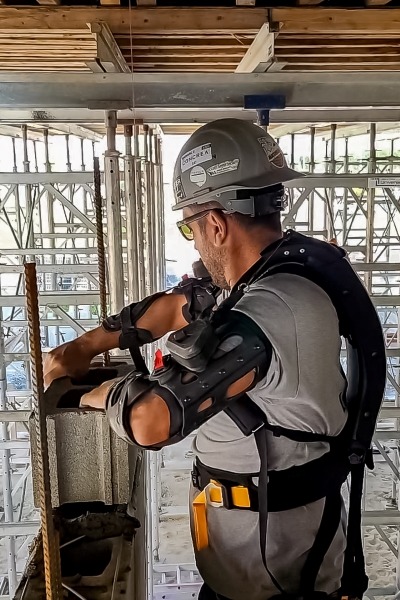The Exoskeleton by Mawashi Science and Technology
Words: Vera Francisco
Words: Vera Autushka, Fraco USA, Inc.
Photos: Photos: Fraco USA, Inc.

The Exo: How It Feels To Wear It
The concept of an exoskeleton is not particularly new; it has been used in the military and medical field for decades, but recently, the exo has been adopted for the construction industry. You may have caught glimpses of exoskeletons in specialized magazines, exhibitions, or social media feeds. Yet, despite the buzz surrounding them, very few interested parties have tried it on. Everyone is wondering: how does it feel to work while wearing the exoskeleton?
To tell the truth, it is very hard to describe the sensation of wearing it. First, I should say that Fraco Exo by Mawashi has several separate modules. You can wear back, arm, and leg modules independently, depending on the task you need to perform at work. For example, masons will mostly need back and arm parts of it. But if you need to squat repeatedly, lifting
heavy blocks, you will need the knee parts too.
Notably, the exo is very lightweight. Many think that the back module feels like a backpack. This assumption is not correct. The exo feels more like a lightweight winter coat. It does not restrict movements, and in a minute or two, you stop noticing that you have it on, the same way you don’t pay attention to the weight of your coat or jacket.
It is quite hard to describe the sensation of lifting heavy blocks while wearing it. Picture yourself in a gym, hoisting your maximum deadlift. Now, imagine a helping hand gently assisting you, subtly easing the load. That's the sensation – your muscles still bear the brunt of the effort, but it feels as though someone is lending a supportive boost.
Yet, perhaps the most elusive aspect to describe is the sense of security it instills. Often, when you lift heavy objects, like blocks, part of the strain transfers to your bones, which, in the long run, builds up and can lead to health problems. The exoskeleton ensures that the weight is distributed directly to your muscles. This mitigates the risk of back injuries. In other words, it makes your muscles, not your back, work.
Getting used to wearing the back module happens almost instantly. Using the arm components of the exoskeleton requires a bit more time for familiarization. Mawashi, Director of Customer Experience, Simon Pesant says it takes from several hours to a few days depending on the user and the task performed. It is a bit less intuitive with the arm parts because the anatomy of the arm is, engineeringly speaking, a more complex system compared to the back. To put it simply, an arm has a wider amplitude of potential movements. The exo must follow the movement, help where it is necessary, and release the tension when the goal of the move is accomplished. Yet, it is not wired directly to your brain. For example, if you lift your arms in the position of butterfly wings and relax them, the exo will hold the arms in this position. This strain is desirable when you lift a block to a certain position. You will need to move the arms slightly back and down to release the hold of the exo.

How To Put The Exo On
It takes about 2-3 minutes to put it on for the first time. You might need assistance guiding you through all the snaps and clips. Yellow markings serve as visual cues, guiding users through the intricate network of clips and straps. Most of it is intuitively clear. The pulling of the straps, however, requires some prompting. You will find a thorough user manual packed with the Exo. With time, donning the exoskeleton becomes second nature, taking a minute to prepare for a day's work.
How Does The Exo Work?
As I have said, the exo consists of several modules. Each of these modules works autonomously, and they replicate the mechanics of the human body. Take, for example, what seems the least complex system – the spine. The spine has a comparatively limited range of potential movements. Its purpose is to support the body. So does the back module of the exo. It does not restrict the natural moments but helps to redirect the strain on the upper body muscles. The back module uses a range of springs to assist the user. When bending over or squatting, the user utilizes gravity to extend the spring; the springs aid the motion and facilitate the user in returning to an upright position.
The arm module is more mechanically intricate. It comprises a system of pulleys and joints that replicate human anatomy. However, because it isn't directly linked to the brain, mastering the manipulation of these additional parts requires learning a few extra movements.
The Price?
Considering all the undeniable benefits of the exo, why doesn't every mason own one by now? The answer is – the cost. With prices ranging into thousands, outfitting an entire workforce can pose a substantial investment. Of course, it is much cheaper to prevent an injury than to treat it. To say nothing about the cost of workforce rotation. Yes, the exo pays its price in the end. But why is it so expensive in the first place? That was the first question I asked Simon Pesant at Mawashi.
The answer is the cost of production. Under the heavy fabric, hidden inside the light plastic parts, lie small yet complex mechanisms. They are very fine and require expensive production procedures, like the processors in computers.
Besides, every clip and strap on the exo is tactical. Take, for example, a clip on the chest. It is made to pull and entrap its other part to shorten the fastening time to milliseconds. All the velcros are made durable and strong. In other words, every small detail is optimized to enhance the power and decrease the weight and the complexity of use to a minimum.
The price of the exoskeleton places it squarely in the category of equipment rather than mere attire. Like any equipment, it requires minimal training and ongoing support. This underscores the importance of selecting a supplier who offers comprehensive customer support. Fraco provides customer service and personalized training to each user to ensure that each worker receives maximum benefits from using the exo.

Longevity Of The Exoskeleton?
Is the exoskeleton just a fad, or is it here to stay? Construction workers are grappling with this question, especially considering the hefty price tag attached to these innovative devices. However, the answer lies in a closer examination of workforce dynamics.
Currently, construction sites are facing a shortage of labor, with job vacancies remaining high. Not only is it challenging to fill these positions with general laborers, but retaining skilled workers presents its own set of obstacles. For employers, the exoskeleton emerges as a potential solution to extend the working life of employees. By helping to prevent work-related injuries and facilitating longer careers, exoskeletons offer a means to tap into a broader talent pool, including traditionally underrepresented groups like women.
Looking ahead, it's conceivable that the next generation of construction workers will be trained to utilize exoskeletons as a standard part of their skill set. As such, incorporating exoskeleton training into masonry education programs could become the norm.
With its ability to attract and retain workers while addressing safety concerns, the exoskeleton market is poised for significant growth. Market analysts predict that by 2035, the market for exoskeletons could reach a staggering $20 billion.
Given these factors, it appears that the exoskeleton is not merely a passing trend but a permanent fixture in the construction industry's toolkit.